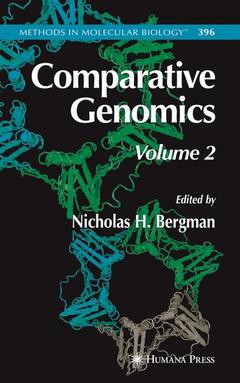Preface v.- Contributors xi.- Table of Contents—Volume 1 xv.- I: Comparative Analysis of Domain and Protein Families.- 1 Computational Prediction of Domain Interactions 3Philipp Pagel, Normann Strack, Matthias Oesterheld, Volker Stümpflen, and Dmitrij Frishman 3.- 2 Domain Team: Synteny of Domains is a New Approach in Comparative Genomics 17Sophie Pasek 17.- 3 Inference of Gene Function Based on Gene Fusion Events: The Rosetta-Stone Method 31Karsten Suhre 31.- 4 Pfam: A Domain-Centric Method for Analyzing Proteins and Proteomes 43Jaina Mistry and Robert Finn 43.- 5 InterPro and InterProScan: Tools for Protein Sequence Classification and Comparison 59Nicola Mulder and Rolf Apweiler 59.- 6 Gene Annotation and Pathway Mapping in KEGG 71Kiyoko F. Aoki-Kinoshita and Minoru Kanehisa 71.- II:Orthologs, Synteny, and Genome Evolution.- 7 Ortholog Detection Using the Reciprocal Smallest Distance Algorithm 95Dennis P. Wall and Todd DeLuca 95.- 8 Finding Conserved Gene Order Across Multiple Genomes 111Giulio Pavesi and Graziano Pesole 111.- 9 Analysis of Genome Rearrangement by Block-Interchanges 121Chin Lung Lu, Ying Chih Lin, Yen Lin Huang, and Chuan Yi Tang 121.- 10 Analyzing Patterns of Microbial Evolution Using the Mauve Genome Alignment System 135Aaron E. Darling, Todd J. Treangen, Xavier Messeguer, and Nicole T. Perna 135.- 11 Visualization of Syntenic Relationships With SynBrowse 153Volker Brendel, Stefan Kurtz, and Xioakang Pan 153.- 12 Gecko and GhostFam: Rigorous and Efficient Gene Cluster Detection in Prokaryotic Genomes 165Thomas Schmidt and Jens Stoye 165.- III:Experimental Analysis of Whole Genomes: A NALYSIS OF C OPY N UMBER AND S EQUENCE P OLYMORPHISMS.- 13 Genome-wide Copy Number Analysis on GeneChip® Platform Using Copy Number Analyzer for Affymetrix GeneChip2.0 Software 185Seishi Ogawa, Yasuhito Nanya, and Go Yamamoto 185.- 14 Oligonucleotide Array Comparative Genomic Hybridization 207Paul van den IJssel and Bauke Ylstra 207.- 15 Studying Bacterial Genome Dynamics Using Microarray-Based Comparative Genomic Hybridization 223Eduardo N. Taboada, Christian C. Luebbert, and John H. E. Nash 223.- 16 DNA Copy Number Data Analysis Using the CGHAnalyzer Software Suite 255Joel Greshock 255.- 17 Microarray-Based Approach for Genome-Wide Survey of Nucleotide Polymorphisms 267Brian W. Brunelle and Tracy L. Nicholson 267.- 18 High-Throughput Genotyping of Single Nucleotide Polymorphisms with High Sensitivity 281Honghua Li, Hui-Yun Wang, Xiangfeng Cui, Minjie Luo, Guohong Hu, Danielle M. Greenawalt, Irina V. Tereshchenko, James Y. Li, Yi Chu, and Richeng Gao 281.- 19 Single Nucleotide Polymorphism Mapping Array Assay 295Xiaofeng Zhou and David T. W. Wong 295.- 20 Molecular Inversion Probe Assay 315Farnaz Absalan and Mostafa Ronaghi 315.- 21 novoSNP3: Variant Detection and Sequence Annotation in Resequencing Projects 331Peter De Rijk and Jurgen Del-Favero 331.- 22 Rapid Identification of Single Nucleotide Substitutions Using SeqDoC 345Mark L. Crowe 345.- 23 SNPHunter: A Versatile Web-Based Tool for Acquiring and Managing Single Nucleotide Polymorphisms 359Tianhua Niu 359.- 24 Identification of Disease Genes: Example-Driven Web-Based Tutorial 371Medha Bhagwat 371.- 25 Variable Number Tandem Repeat Typing of Bacteria 395Siamak P. Yazdankhah and BjØrn-Arne Lindstedt 395.- 26 Fluorescent Amplified Fragment Length Polymorphism Genotyping of Bacterial Species 405Meeta Desai 407.- 27 FLP-Mapping: A Universal, Cost-Effective, and Automatable Method for Gene Mapping 419Knud Nairz, Peder Zipperlen, and Manuel Schneider 419.- Index 433.





